India to ramp up critical mineral auctions to cut import dependence by 2031, Union Minister Satish Chandra Dubey says
This initiative forms part of a broader strategy to enhance India’s mineral security and reduce vulnerability to international supply chain disruptions.

India plans to maximise the auction of critical mineral blocks by 2031, Satish Chandra Dubey, Union Minister of State for Mines and Coal, has said.
Speaking at a FICCI conference, Critical Minerals Matrix, in New Delhi today, Dubey outlined the government’s strategic approach to reducing import dependency for critical minerals.
“The government has already auctioned 24 critical mineral blocks domestically, and we aim to auction as many critical mineral blocks as possible by 2031,” the minister said. This initiative forms part of a broader strategy to enhance India’s mineral security and reduce vulnerability to international supply chain disruptions.
The announcement follows the recent launch of the National Critical Minerals Mission, which has allocated ₹34,300 crore over seven years to strengthen India’s position in the critical minerals sector.
The minister emphasised the role of public-private partnerships in achieving these objectives. “We must work as complementary partners and as a team to build a self-reliant India,” Dubey stated, urging increased private sector involvement in mineral exploration and extraction activities.
The announcement comes amid growing concerns about critical mineral supply chains, particularly for materials essential to electric vehicles, electronics manufacturing, and renewable energy systems.
On the occasion, Dhiraj Nayyar, Group Chief Economist at Vedanta, highlighted the urgency of developing domestic resources, noting that electric vehicles require six times more minerals than conventional cars, while offshore wind infrastructure demands nine times more minerals than traditional power plants. “We don’t want to move from import dependence on oil to import dependence on critical minerals. The key is exploration,” Nayyar emphasised, calling for streamlined approval processes and increased flexibility in land allocation for exploration activities.
Recommended Stories
A FICCI-Deloitte report, Recovery of Critical Minerals from Mine Tailings and Overburden, launched at the conference, said India’s critical minerals demand is poised for exponential growth across key sectors. Rajib Maitra, Partner at Deloitte, highlighted that lithium demand alone is expected to increase nine to tenfold over the next decade. The report identifies significant opportunities in recovering critical minerals from mine tailings and overburden.
The report outlines four key strategic areas for development: policies and incentives, extraction processing technologies, supply chain integration, and capacity building. It recommends establishing critical mineral recovery zones with public-private partnerships, creating a nationwide assessment database for mine tailings, and developing dedicated regulatory frameworks for mineral extraction.
In addition, it emphasises the importance of international collaboration, suggesting that India could learn from successful models implemented in Australia, the United States, Japan, and Canada, where specific funds and collaborative development programmes support critical mineral recovery from tailings.